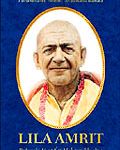Kailash Ashram
From this time on, Sri Devpuriji appeared in public more often. He left the Abu Mountains and first went to Nasirabad, near Ajmer in Rajasthan. Here also there was a post of the British military. The British officers who came to know him were deeply impressed by him.
From Nasirabad he travelled to Kailash village in the Sikar district of Rajasthan. Here he told the inhabitants that he wanted to build an ashram. As Sri Devpuriji was by now well known to the people of this region, they recognised the great fortune of having him live near them and hearing his sermons. Therefore they were willing to do anything for him and soon built a beautiful two-storey building to serve as an ashram.
Kailash Ashram is situated on a small hill in the desert. From it one has a sweeping view of majestic sunrises and sunsets. To the north one can see ponds and a river and behind the river is an avenue of trees. In the opposite direction, several kilometres away, sits the village of Kailash. With the farmers' huts of thatched straw in shades of soft browns and greys, the scene resembles a pastel painting. A long valley opens out to the west and in the distance is a semicircle of rugged brown hills.
The ashram is constructed very simply. The basic material is whitewashed stone. Both levels have open terraces and large banyan trees give shade to the building. According to Vedic tradition, in the centre of the ashram is a havana kunda[1]. The whole building is an ideal place for yogis and meditators. The air is clean and pure and one can gaze, unhindered, far into the distance.
In this new ashram Sri Devpuriji began to give lectures on The Ramayana, the great epic poem of Sri Goswami Tulsidas. News quickly spread of the wonderful satsangs[2] and soon many more listeners came. To reach the ashram they travelled, by foot, oxcart and camel, long distances through the desert.
The journeys of these people lent a picturesque sight to the desert. Not for nothing is Rajasthan called, "the land of colours." The men wear yellow, red or pink turbans, the women wear long coloured saris and skirts of hand-printed fabric in brilliant colours. At work in the field the farmers' wives look like flocks of lively, exotic birds in the rich green pastures.
After sunset, campfires before the ashram became a common sight. Accompanied by the rhythm of instruments, the villagers came and left the day behind them as they gathered in satsang. Here on the edge of the desert under a clear night sky, it seemed as if peace had descended upon the whole land.
Every day Sri Devpuriji preached in the ashram and his words were like heavenly nectar for the listeners. There was always enough food and drink. Prasad[3] was generously distributed and the question was not whether there was enough, but rather, "Where did all this come from?"
No-one was ever seen buying food for the ashram and no deliveries were ever made. It is known that Lakshmi, the Goddess of Fortune and Kubera, the god of prosperity, are at the service of siddhas and people were convinced that it was these Divine helpers who provided for the ashram.
The following story was told to me by a villager who is still living in Kailash.
One day he came to Sri Devpuriji in great despair because he lacked money to meet even his most basic needs. Sri Devpuriji lifted up one corner of the blanket on which he was sitting and revealed a great quantity of British coins. Sri Devpuriji allowed the poor villager, who was quite astonished, to take as much as he needed.
As many other devotees had similar experiences, the impression grew that Sri Devpuriji kept a large sum of money hidden under his blanket. One day, just after giving some coins away, Sri Devpuriji left the room and in his absence, someone seized with curiosity lifted Sri Devpuriji's blanket to see how much money was really hidden underneath. But nothing was there, only bare floor.
Each day many wonderful things happen around a Saint.
For more than three years Sri Devpuriji preached daily, but gradually it became the villagers' habit to visit the ashram merely to enjoy the pleasant atmosphere and the good food. Not one among them practised yoga or seriously tried to incorporate the teachings into their daily life.
When Sri Devpuriji realized that he was wasting his time, he decided to stop the satsangs.
One day when everyone had gathered, he suddenly called out, "Quick, leave the ashram! The top floor is falling down!"
The building was new and solidly built, so no-one believed that it could fall apart. But under the penetrating gaze of Sri Devpuriji the top floor cracked, swayed and splintered and the walls crashed down. As quickly as they were able, the people fled from the ashram. Miraculously no-one was hurt.
But that wasn't all. Sri Devpuriji let out a strange hum which lured snakes[4] from all directions and he did not cease until the last of the visitors ran away.
For a long time the villagers spoke about this frightening episode, but they could find no explanation for Sri Devpuriji's actions. Most thought he had gone mad and very few attempted to discover the real reason for what had happened.
And so Sri Devpuriji ended his public sermons. From that time on, he only spoke to those individuals whose paths, in one way or another crossed his, or to those who came to him for help.
Today, Kailash Ashram has been extended. It now has a large hall for meditation and a plaque commemorating Sri Devpuriji. However, the older part of the building remains unchanged since the moment of its collapse. The fallen stones have long ago been removed, but if you climb to the roof it is possible to recognise the former wall of the top floor.
[1]havana kunda = fireplace
[2]sat = truth, sanga = gathering, society. Satsang is a ceremonial celebration and meeting in the service of Truth
[3]prasad = food blessed by God, such as nuts, fruit and sweets. It is distributed after prayer during the satsang.
[4]Snakes belong to Lord Shiva. Once when he lived in the jungle, snakes crawled over his body while he sat in mediation. Snakes are also messengers of change.
Next Chapter: Nath Babaji
Previous Chapter: The Wild Aghoris








